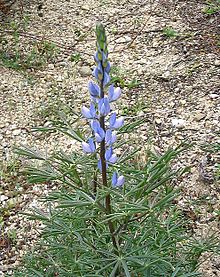Lupinus

Lupinus, commonly known as lupin or lupine,[note 1] is a genus of flowering plants in the legume family Fabaceae. The genus includes over 199 species, with centers of diversity in North and South America.[1] Smaller centers occur in North Africa and the Mediterranean.[1][2] They are widely cultivated, both as a food source and as ornamental plants, although in New Zealand’s South Island, introduced lupins are viewed as a severe environmental threat.[3]
The species are mostly herbaceous perennial plants 0.3–1.5 m (0.98–4.92 ft) tall, but some are annual plants and a few are shrubs up to 3 m (9.8 ft) tall. An exception is the chamis de monte (Lupinus jaimehintoniana) of Oaxaca in Mexico, which is a tree up to 8 m (26 ft) tall.[4] Lupins have soft green to grey-green leaves which may be coated in silvery hairs, often densely so. The leaf blades are usually palmately divided into five to 28 leaflets, or reduced to a single leaflet in a few species of the southeastern United States and eastern South America.[5] The flowers are produced in dense or open whorls on an erect spike, each flower 1–2 cm long. The pea-like flowers have an upper standard, or banner, two lateral wings, and two lower petals fused into a keel. The flower shape has inspired common names such as bluebonnets and quaker bonnets. The fruit is a pod containing several seeds.
Seeds of various species of lupins have been used as a food for over 3000 years around the Mediterranean[7] and for as long as 6000 years in the Andes.[8] Lupins were also used by many Native American peoples such as the Yavapai in North America. The Andean lupin or tarwi (Lupinus mutabilis) was a widespread food in the Incan Empire; but they have never been accorded the same status as soybeans, dry peas and other pulse crops. The pearl lupin of the Andean highlands of South America, Lupinus mutabilis, known locally as tarwi or chocho, was extensively cultivated, but no conscious genetic improvement other than to select for larger and water-permeable seeds seems to have been made. Users soaked the seed in running water to remove most of the bitter alkaloids and then cooked or toasted the seeds to make them edible,[9] or else boiled and dried them to make kirku,[10] reported as a pre-Columbian practice in Las Relaciones geográficas de Indias.[11] Spanish domination led to a change in the eating habits of the indigenous peoples, and only recently[12] (late 20th century onward) has interest in using lupins as a food been renewed.[13][14]
Lupins can be used to make a variety of foods both sweet and savoury, including everyday meals, traditional fermented foods, baked foods, and sauces. The European white lupin (L. albus) beans are commonly sold in a salty solution in jars (like olives and pickles) and can be eaten with or without the skin. Lupini dishes are most commonly found in Europe, especially in Portugal, Spain, Greece, and Italy. They are also common in Brazil and Egypt. In Egypt, the lupin is known in Arabic as ترمس termes, and is a popular street snack after being treated with several soakings of water, and then brined. In Portugal, Spain, and Spanish Harlem, they are consumed with beer and wine. In Lebanon, Jordan, Syria, Palestine, and Israel, salty and chilled lupini beans are called termos and in Hebrew turmus (תורמוס) and are served as part of an apéritif or a snack. Other species, such as L. albus (white lupin), L. angustifolius (narrow-leafed lupin),[15] and Lupinus hirsutus (blue lupin)[16] also have edible seeds.[17]
